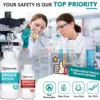Common Chemical Hazards and How to Mitigate them
Chemicals play a significant role in various industries, from manufacturing and construction to healthcare and agriculture. While these substances are essential for many processes, they also pose significant hazards if not handled and managed properly. In this blog post, we will explore some of the most common chemical hazards encountered in the workplace and discuss effective mitigation strategies to ensure a safe working environment for everyone involved.
1. Understanding Chemical Hazards:
Before diving into mitigation strategies, it is crucial to identify the different types of chemical hazards commonly found in the workplace. Here are some of the most prevalent chemical hazards:
- Flammable and combustible substances
- Corrosive chemicals
- Toxic and hazardous materials
- Reactive chemicals
- Carcinogens
- Asphyxiants
- Irritants
2. Mitigation Strategies for Chemical Hazards:
a) Proper Handling and Storage:
One of the fundamental aspects of chemical hazard mitigation is ensuring the correct handling and storage of hazardous substances. Employ these strategies to minimise risks:
- Train employees on proper handling techniques and provide them with appropriate personal protective equipment (PPE).
- Store chemicals in well-ventilated areas away from incompatible substances.
- Clearly label all containers and ensure they are tightly sealed.
- Implement a proper inventory management system to track and control chemical usage.
b) Risk Assessment and Management:
Conducting a thorough risk assessment is essential to identify potential chemical hazards in the workplace. Follow these steps to effectively manage risks:
- Identify all chemicals present and assess their associated hazards.
- Evaluate the likelihood and potential severity of accidents or exposures.
- Implement control measures such as substitution, isolation, or engineering controls to minimise risks.
- Regularly review and update risk assessments as new chemicals or processes are introduced.
c) Personal Protective Equipment (PPE):
Using appropriate personal protective equipment is vital for safeguarding employees against chemical hazards. Consider the following recommendations:
- Conduct a PPE assessment to determine the required protective gear.
- Provide employees with gloves, goggles, respirators, and other necessary equipment.
- Train workers on the correct usage, maintenance, and limitations of PPE.
- Regularly inspect and replace damaged or outdated protective gear.
d) Emergency Preparedness:
Preparing for chemical emergencies can save lives and mitigate potential damage. Here are some key emergency preparedness strategies:
- Develop an emergency response plan and train employees on its implementation.
- Install safety equipment such as eyewash stations, emergency showers, and fire extinguishers.
- Establish evacuation routes and conduct regular drills to ensure everyone is familiar with the procedures.
- Designate responsible individuals to coordinate emergency responses and communicate with external agencies, if needed.
Conclusion:
Chemical hazards are a significant concern in various industries, and their proper management is crucial to ensure workplace safety. By understanding the different types of chemical hazards and implementing effective mitigation strategies, we can create a secure environment for employees and minimise the risks associated with chemical exposure. Remember, continuous monitoring, employee training, and strict adherence to safety protocols are essential for preventing accidents and maintaining a healthy work environment.
With Morven Industrial, you can get all the Personal Protective Equipment needed at the workplace to protect against chemical hazards. With a wide variety of quality products available, you can easily find what you’re looking for and have it delivered to you. Contact us today to get yours.






